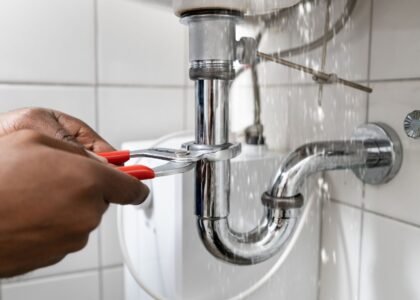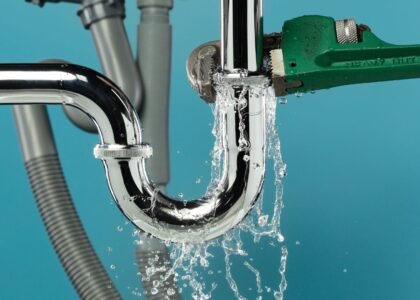Introduction
Leaks are sneaky. At first, they whisper — a damp patch, a slow drip — but left unchecked, they can wreak havoc on your home’s structure, your plumbing system, and your wallet. Inglewood’s climate and older homes make it particularly important to identify leaks early.
In this post, you’ll learn:
- Warning signs of hidden leaks
- Common leak types in residential plumbing
- How professionals perform leak detection
- What to do next if you suspect a leak
(And if you’re ready to schedule, check out our expert leak detection service page.)
Why Hidden Leaks Are Risky
Even small leaks can lead to major problems:
- Structural damage — moisture can weaken beams, floors, drywall, and foundations.
- Mold & mildew — damp zones are breeding grounds for mold, which is unhealthy and expensive to remediate.
- Increased water bills — water waste adds up quickly.
- Secondary damage — leaks can damage floors, carpets, electronics, or walls.
- Loss of water pressure — if a pipe is compromised, pressure may drop elsewhere in your system.
Because of these risks, early detection is critical.
Common Types of Leaks in Inglewood Homes
Knowing what types of leaks occur can help you watch for specific signs:
| Leak Type | Usual Location | Common Signs |
|---|---|---|
| Slab leak | Under concrete foundation | Soft spots in floor, warm patches, unexplained moisture |
| Line leak (water supply) | Behind walls, under floors | Drop in pressure, higher meter readings, pool of water |
| Toilet or faucet leak | Fixtures, toilets | Constant running water, dripping, odor |
| Sewage / sewer line leak | Sewer system, lateral lines | Foul smell, soggy ground, sink backups |
Many Inglewood homes, especially older ones, may experience slab leaks because their plumbing lies under concrete slabs. Detecting leaks under an existing slab is tricky, which is why professional leak detection is so helpful.
Early Warning Signs of a Hidden Leak
Keep a lookout for these “soft signals” that something’s wrong:
- Sudden spikes in your water bill without increased usage
- Sound of running water when no fixtures are on
- Wet spots, puddles, or soggy soil in the yard
- Musty smells or mildew in walls, floors, or ceilings
- Cracks in walls or floors (could suggest shifting due to moisture)
- Reduced water pressure in certain areas of your home
- Hot spots on floors (for slab leaks)
If you notice any of these, don’t wait — it’s time for a professional leak detection.
How Professional Leak Detection Works
Plumbers specializing in leak detection use non-invasive methods to pinpoint leaks without tearing out walls. Here are the main techniques:
Acoustic Listening & Sound Detection
A sensitive microphone or sensor “listens” for the sound of water escaping pipes behind walls or under slabs.
Thermal Imaging
Infrared cameras detect temperature differences; a leaking pipe often shows up as a cool or warm spot compared to its surroundings.
Pressure Testing
Sections of your system are isolated and pressurized to detect drops in pressure, indicating a leak.
Tracer Gas (Dry or Wet)
A harmless gas is injected into the piping, then sensors detect where it escapes.
Moisture Meters & Hygrometers
These measure moisture levels inside walls or under floors to detect hidden damp areas.
Video Camera Inspection
A small waterproof camera is sent through pipes to visually inspect the interior for cracks, leaks, or defects.
Each method has pros and cons (cost, area of coverage, material compatibility), so professional technicians often combine multiple methods to maximize accuracy.
Why Professional Detection Beats DIY
You might be tempted to try to “find a leak yourself,” but there are limitations:
- You may damage walls, flooring, or finishes
- You’ll likely find only surface leaks, not subsurface or slab leaks
- Misdiagnosis may lead to unnecessary repairs
- You may miss the actual source and only address the symptom
By contrast, a pro can:
- Use non-invasive tools
- Pinpoint the leak source precisely
- Minimize disruption to your property
- Integrate detection & repair planning
If you want a professional to handle it end to end, visit our contact page.
Steps to Take When You Suspect a Leak
Here’s a quick checklist:
- Shut off the water main (if the leak is significant)
- Note where the leak seems to originate
- Take photos or videos of the area
- Keep the area dry to prevent damage
- Call for professional leak detection
Make sure the plumber you call is experienced in slab leak detection, acoustic leak detection, or infrared methods depending on your situation.
Case Study: A Real Inglewood Leak Discovery (Hypothetical)
This illustration shows how a hidden slab leak might unfold:
- Homeowner notices warm patch on floor and subtle increase in water bill
- They check toilets and faucets—no visible drips
- Contact a professional leak detection team
- Technician uses acoustic listening first — identifies approximate zone
- Then thermal imaging pinpoints the exact location
- Minimal surface area is cut; repair is made
- Final test ensures no further leakage
This is just one scenario. Many real-life cases in Inglewood require specialized detection due to slab plumbing or complex pipe layouts.
Preventive Tips to Reduce Leak Risk
You can’t prevent every leak, but you can reduce your risk:
- Inspect plumbing regularly (e.g. annual checks)
- Insulate pipes to reduce expansion/strain
- Avoid sharp bends when doing renovations
- Monitor humidity levels
- Flush your water heater occasionally
- Watch for signs early (see previous section)
If you want more guidance or to schedule periodic checkups, reach out via our contact page.



